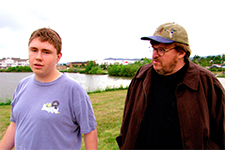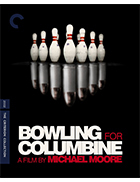Bowling for Columbine [Blu-Ray]
|

What I admire most about Michael Moore's polarizing documentary Bowling for Columbine is that is does not attempt to supply easy answers—or really any answers at all—to the issues it explores. Moore has admitted in interviews that, when he embarked on making a film about American gun culture in the wake of the 1999 Columbine High School massacre, he was sure that he would discover that the problem was the sheer number of guns in the United States and the answer was stricter gun control legislation and fewer available firearms. But, then the production took him to Canada, where he discovered a culture in which there are millions of guns in the hands of private citizens and only a fraction of the annual murders we have in the U.S. (and seemingly everyone leaves their front doors unlocked). It was at that point that Moore realized he wasn't just looking at gun culture in America, but rather how gun culture is just one facet of a long and disheartening history of violence at the core of American identity. And that became the film's subject—not guns, but America itself. That's a big subject to chew on, and Moore does his best to take as many bites as he can in his uniquely populist, rabble-rousing way. Moore is both a polemicist and an entertainer, a pop historian with more than a few political axes to grind, and his films are at their best when he hits us with hard truths and thought-provoking inquiry while also making us laugh. Bowling for Columbine is filled with moments that make us both chuckle and wince, beginning with the opening segment in which Moore opens an account at a bank that promises a free gun to all new account holders. It's an auspicious beginning that sets a tone of fundamental absurdity, but what makes the film memorable is the way Moore digs beneath the politically riven surface and reminds us that the problems we're facing today (and we are still facing them, more than ever, in the decade and a half since the film's release) are just new iterations of the same ol', same ol'. The breadth of the subject matter takes Moore to a wide range of locations and interactions with a host of intriguing people, both famous and obscure. He begins, as he often does, in his home state of Michigan, where he secures himself a free rifle with his new checking account and then spends some time in the frigid wilderness with a local militia that is intent on assuring him that they're not a bunch of anti-government whackos, but rather patriots who are ready for the call of duty. He conducts a lengthy interview in the kitchen of James Nichols, brother of convicted Oklahoma City bombing accomplice Terry Nichols, who grows steadily more unhinged as the interview goes on, at one point taking Moore back to his bedroom to show him the loaded gun he keeps under his pillow, which he (apparently) puts to his head at one point. As the title suggests, Columbine is a major thread woven throughout the film, not just the high school massacre itself (some of which we see in sickening, grainy black-and-white surveillance footage and hear via previously unheard 911 calls), but the striking oddity almost entirely ignored by the media that the small Denver suburb is home to Lockheed Martin, one of the country's largest weapons manufacturers. It's really more of an unsettling coincidence than anything, but Moore still uses the proximity of this manufacturer of bombs and missiles—some of which were used by the U.S. military on the day of massacre—and the wholesale slaughter of 12 high school students and teachers. Later in the film, Moore interviews two Columbine survivors and takes them to the corporate headquarters of K-Mart, who sold the bullets they were shot with. In a striking moment of completely unexpected success, Moore's stunt, in which he and the wounded teenagers set up in the lobby of K-Mart headquarters and challenge a procession of spokespeople and managers, results in the retail giane officially announcing the phase-out of handgun ammunition. The interview that most people remember, though, is the one that Moore conducts with Charlton Heston, former Hollywood star and then president of the National Rifle Association (NRA). Moore, himself an NRA member who grew up shooting guns, minces no words with Heston, particularly in relation to the NRA's holding its annual meeting in Denver just a week after Columbine, a decision that seems thoughtless at best, downright cruel at worst. Heston ends the interview rather abruptly, walking off on Moore as he continues shouting questions at him, thus giving the film its most adept symbolic image of how so many feel in confronting the gun lobby: Asking desperate questions that simply fall on deaf ears. But, again, Bowling for Columbine is about much more than guns; rather, it is about the prevalent, arguably defining, nature of violence in American culture. Moore makes this abundantly clear in an animated sequence that details the long history of institutional violence throughout American history and how so much of it was and continues to be driven by fear. Fear turns out to be the real tie that binds, linking together the military-industrial complex and the obsession with firearms in a way that is both absurd and sobering. Like all of Moore's cinematic polemics, Bowling for Columbine is highly entertaining and just a bit sloppy, moving from segment to segment via loose association that does eventually pull together at the end. Moore is present throughout the film, as he casts himself as the everyday, baseball-hat-wearing American schlub just trying to figure out what's going on, and how you feel about his personality and screen presence will largely determine how well the film works for you. This was only his third documentary feature, following Roger & Me (1989) and The Big One (1997), both of which had established Moore's persona and its centrality to his muckraking methodology. I have never had a problem with Moore, even as I recognize how some of his tendencies can grate, especially against those whose political sensibilities are different from his. Yet, trying to dismiss him as some kind of obnoxious leftwing provocateur is just a means of dodging the strength of the uncomfortable points he makes and the unique position he occupies as a product of working-class America whose allegiances remain rightly connected to the struggling and powerless. Sometimes he gets us to laugh at what we're seeing, but just as often he hits us hard with sobering realities that have only become more pertinent and troubling in the ensuing years. Moore was right not to try to reach some grand conclusion because we are, unfortunately, still trying to figure it out.
Copyright © 2018 James Kendrick Thoughts? E-mail James Kendrick All images copyright © The Criterion Collection / MGM | |||||||||||||||||||||||||||||||
Overall Rating:



 (3.5)
(3.5)
Subscribe and Follow
Get a daily dose of Africa Leader news through our daily email, its complimentary and keeps you fully up to date with world and business news as well.
News RELEASES
Publish news of your business, community or sports group, personnel appointments, major event and more by submitting a news release to Africa Leader.
More Information
